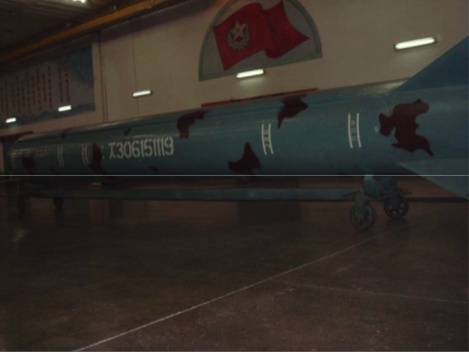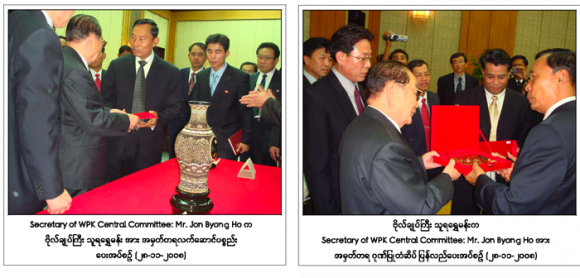This image of a North Korean Scud (or Nodong) missile has appeared here before — in black-and-white. Wonk-reader Tal Inbar sent it along to Geoff Forden, who posted it, noting that it appeared to have been taken in the final assembly hall of a DPRK missile facility.
I had forgotten the image, until I started working on this paper about Burma (aka Myanmar). The image is part of a large collection of photographs from a visit by a Burmese military delegation to the DPRK in 2008. Irawaddy and the Democratic Voice of Burma have made available the photographs, as well as a purloined trip report (Burmese|English). (Josh Pollack talks about the implications of these documents in a piece for 38 North, entitled North Korea’s Nuclear Exports: On What Terms?)
The Burmese delegation visited the facility, which the trip report describes as being in a suburb of Pyongyang:
Observations made at the Surface to Surface Missile Factory on 11-28-2008
47. It is located in a suburb in Pyongyang. It produces SCUD missiles. The component producing lines are kept in the underground tunnel. There are also above-ground factory where missile engines are assembled, where missile bodies are produced and assembled, and where complete missiles are assembled. In the factories that produce complete missiles, there are places that produce and assemble SCUD-D and SCUD-E. While SCUD-D can shoot a target up to 700 kilometers away, SCUD-E can shoot up to 1,500 kilometers, and SCUD-F can shoot up to 3,000 kilometers.
I spent a little time last year, working on a paper on North Korea’s missile infrastructure, in which I tried to make an estimate of how many missile-related factories North Korea might have. (Short answer: I have no idea.)
The best summary I found of what little we know about the principal facility believed to be associated with Scud-derivatives, the so-called Pyongyang Pig Factory, was this description by friend-o-wonk Dan Pinkston:
No. 125 Factory (125號 工場), or the so-called “Pyongyang Pig Factory” in northwestern Pyongyang, reportedly produces Hwasŏng, Nodong, and surface-to-ship cruise missiles. Officials from Middle Eastern countries and possibly elsewhere have reportedly visited the factory, but the extent of their tours is unknown. Much of the open source information is based upon the testimony of Ch’oe Ju-hwal, a former KPA colonel who defected to South Korea. However, Ch’oe was not assigned to the factory, and he never served in any missile-related unit; some of the information in his statements could be from other sources or speculative. The so-called Sanŏp-dong (San’ŭm-dong) facility could be the research and design component of the No. 125 Factory, or another name for the same facility.
Specifically, Ch’oe Ju-hwal asserted that the Middle Eastern countries that sent officials were Egypt and Iran. I looked around the suburbs of Pyongyang in Google Earth for a bit, but nothing popped out immediately. As we have discussed before, I am a lousy imagery analyst, so other people may wish to take a look.
I was a little bothered by the trip report’s use of the term “Scud” — which is an American designation for the missile that the North Koreans call Hwasŏng. (The references to the unknown variants Scud-E and Scud-F missiles also bothered me). But, after some consideration, it seems plausible. I’ve been told the the DPRK’s clandestine activities with regard to Pakistan (like Burma, a former British colony) were conducted in impeccable English. And, a colleague reminded me that, when Indian customs officials bordered a North Korean freighter in 1999, they found “ream upon ream of engineers’ drawings labeled ‘Scud B’ and ‘Scud C.'”
English, it’s the language of international commerce!
The list of Scuds is also interesting. The ranges listed for the Scud B, C and D are are all consistent with those in Ballistic and Cruise Missile Threat. Although I initially scratched my head at the Scud E and Scud F, based on range and fuel type the Scud E seems to refer to the Nodong and the SCUD F to the “new IRBM” known as the Musudan. Again, Nodong and Musudan are US designations based on place. (For more on the Musudan range, see David Wright’s posts over all All Things Nuclear: Range Estimates for the Musudan Missile|More on Musudan Range Estimates.)
The whole report is really worth a read and the photographs, well, wow! Here is Jon Byon Ho — North Korea’s proliferator-in-chief — exchanging gifts with Burmese General Shwe Mann. Feel free to submit your own caption; I’ve imagined a couple of one-liners from Jon:
“This is the same plate I gave General Suleiman just before the Israelis shot him in the face.”
“It’s actually a ring magnet. We smuggled 10,000 of the damn things through Dubai before deciding to go with ball bearings. Now we just give them away to guests.”
“What do you mean it has an inscription in Urdu? I thought it was just a pattern. Ok, so I admit — I re-gifted it.”



Wow!I guess pigs really can fly,at least the ones made in the DPRK
caption 1: “Congratulations, Team America — you have stopped nothing!”
can also be used as a caption on Tahrir square protest pictures, and on Af/Pak/Yemen/Somalia/Iraq/Algeria/Jordan unrest pictures.
caption 2: “Copy of the angry letter from Hans Brix”
“What are you talking about? There’s nothing wrong with the TEL. On a polished floor you can get it up to quite a speed you know.”
Though doesn’t this disprove the theory that north Korea just resells others’ missiles? If north Korea is willing to show off a scud factory to visitors.
No. Please consider that we do not know what exactly the North Koreans do at that factory.
Do they build complete missiles from sheet metal and other raw materials – or do they simply restore old, imported missiles (already factory-tested by the original manufacturer) to working condition (keep in mind that those missiles might have been disassembled for transport – and that the North Koreans at least re-paint their Scuds in a spiffy new color scheme…)?
The lack of adequate factory testing activity clearly points to the latter in my eyes.
Let’s take a look at the typical storage periods for 8K14/Scud-B missiles the east-german army used:
Those missiles could be stored (unfueled) for up to 22 years, but were subject to regular inspections during that timeframe, at first every two years, after 15 years every year.
If they didn’t pass those inspections or after those 22 years had passed, a TW aka ‘Technische Wartung’ (technical maintenance) allowed reconditioning that particular missile. During that TW, the missile body was partially disassembled (or rather broken down into ist main assembly groups – there were specific design-features included for this, like easily replaceable riveted joints instead of weld-seams at particular places) and worn-out components got replaced.
I know pictures of this process from which you could get the impression that the Scud-B was manufactured in East-Germany, too, but rest assured that this was definitely not the case. Just (comparably) simple maintenance work. And if your car mechanic replaces a broken engine part, you wouldn’t have to re-certify the whole car either, isn’t it?
My guess is that this is what happens at the ‘Pyongyang Pig Factory’, too. At least considering Scud-B and -C, possibly also the Nodong-1 (it’s a different story with their other designs – but are those really ‘mass-produced’, or even actually working? I’m not so sure about that…).
“It is not an ancient Ming vase you silly billy: for our fusion gadget we skipped obloid and went to vase shape directly!” (everyone missed the true subject of the first picture)
“Here, if you hold our Mk.II Po initiator disk just right it might not fizzle”
re “English, it’s the language of international commerce”
I’m reminded of a Chinese-manufactured anti-ship cruise missile that Iraq fired at a Kuwaiti shopping mall during the second Gulf War. It had English markings for easier sales worldwide; in that case, however, some thought–at least at first–that the English markings meant it had been fired by US forces.
Let me take a try at identifying those ‘Scud’-types (‘Scud’ was originally a NATO-codename used for a line of Wasserfall-SAM-derived soviet surface-to-surface-missiles):
Scud-B(DPRK) = Scud-B(NATO)/SS-1c(DoD)/8K14(GRAU)/R-17(Makeyev)/Shahab-1(Iran)
Scud-C(DPRK) = Scud-C(NATO)/SS-1d(DoD)/9M77?(GRAU)/Shahab-2(Iran)
Scud-D(DPRK) = possibly Nodong-1 aka ND-1(NRO/CIA?)/Shahab-3(Iran)/Ghauri-1(Pakistan) – certainly NOT Scud-D(NATO)/R-17VTO(Makeyev)
Scud-E(DPRK) = possibly ND-2(NRO/CIA?) – the missile with the triconic RV on the five-axle-TEL; The type displayed in Pyongyang differs in certain aspects from the iranian Ghadr-1, although at least one Mock-Up frequently paraded in Teheran (with the number ‘EV3.E003’) shows the north-korean configuration;
Scud-F(DPRK) = possibly MA-1?(NRO/CIA?) – the missile on the six-axle-TEL we alternatively know as ‘Musudan’ or ‘NoDong-B’, which, as i understand, was first sighted some years ago at/near the Mirim airbase;
To add to the confusion, we know from the Kuwolsan-material that the North-Koreans apparently also had a hand in the development of the syrian ‘Scud-D’ (which again doesn’t have anything in common with the original NATO Scud-D/R-17VTO Aerofon)…so, alternatively, it is also possible that it’s:
Scud-D(DPRK) = Scud-D(Syria)
Scud-E(DPRK) = ND-1(NRO/CIA?)
Scud-F(DPRK) = ND-2(NRO/CIA?)
Although, considering the range information, the first variant seems to be somewhat more consistent (this strictly refers to the variant, not the range estimate itself…).
Jochen:
It is lovely to have you back.
I suspect that the Syrian Scud-D is the North Korean Scud-D and, as I noted, that the Scud E and Scud F correspond to the Nodong and the “new IRBM” sometimes called the Musudan.
Nodong-A and B would be US designations, but I have only seen Nodong and New IRBM in official documents. (I presume the “new IRBM” is the one that leaks refer to as the Musdan.)